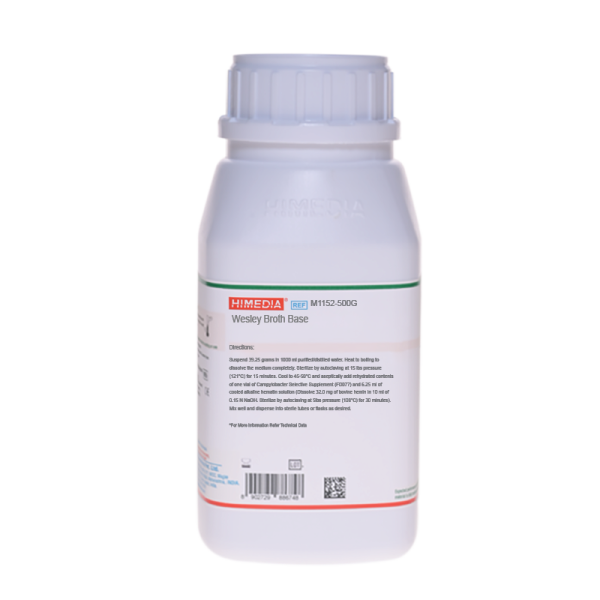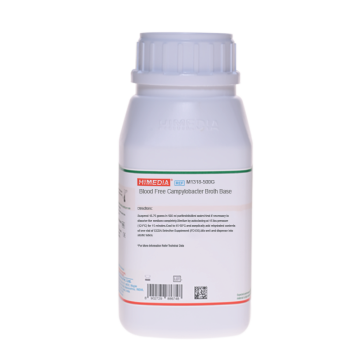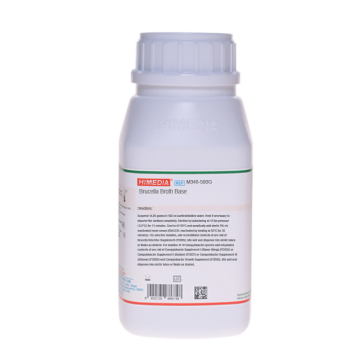 Your enquiry has been submitted
Your enquiry has been submitted
Wesley Broth Base
Wesley Broth is recommended as a selective enrichment medium for isolation of Campylobacter jejuni from poultry products as per APHA.
Composition**
| Ingredients | Gms/Litre |
|---|---|
| Tryptose | 20.000 |
| Yeast extract | 2.500 |
| Sodium chloride | 5.000 |
| Ferrous sulphate | 0.250 |
| Sodium metabisulphite | 0.250 |
| Sodium pyruvate | 0.250 |
| Bicine | 10.000 |
| Agar | 1.000 |
**Formula adjusted, standardized to suit performance parameters
Directions
Suspend 39.25 grams in 1000 ml distilled water. Heat to boiling to dissolve the medium completely. Sterilize by autoclaving at 15 lbs pressure (121°C) for 15 minutes. Cool to 50°C and aseptically add rehydrated contents of 1 vial of Campylobacter Selective Supplement (FD077) and 6.25 ml of cooled alkaline hematin solution (Dissolve 32 mg of bovine hemin in 10 ml of 0.15 N NaOH). Sterilize by autoclaving at 5lbs pressur (108°C) for 30 minutes. Mix well before dispensing.
Principle And Interpretation
Campylobacter jejuni is a gram-negative, rod-shaped curved bacterium commonly found in the intestines of poultry, cattle, swine, rodents, wild birds, cats and dogs. C. jejuni is recognized as a leading cause of acute bacterial gastroenteritis in humans due to eating the food of animal origin. C. jejuni is often isolated from patients with diarrhea at greater isolation rates than reported for Salmonella species. This organism does not grow below 30°C and is sensitive to normal atmospheric concentration of oxygen. Due to this reason, only small numbers of Campylobacters may be present in foods. Hence selective enrichment is needed to detect the few culturable cells of C. jejuni that may be present. C. jejuni survives best in foods held at refrigeration temperature but is highly susceptible to freezing conditions (3, 4) and also sensitive to sodium chloride Wesley Broth is formulated as described by Wesley (1) and recommended by APHA (2) for selective enrichment of C. jejuni from poultry products.
Wesley medium is an ideal enrichment medium suitable for the isolation of C. jejuni. The medium contains tryptose and yeast extract, which provide nitrogenous nutrients, vitamin B complex and other growth nutrients to the organisms. Sodium metabisulphite and ferrous sulphate help in survival and easy recovery of the organism. Sodium pyruvate increases the oxygen tolerance of C. jejuni (5).
Agar in small quantity helps to create microaerophilic atmosphere. Bicine gives good buffering capacity to the medium. Wesley Broth (90 or 100 ml) is inoculated with 10 or 25 grams of food respectively and incubated with agitation under a microaerobic atmosphere at 42°C for 16-18 hours. The enriched culture is plated onto selective media and the plates are incubated at 42°C for upto 48 hours under microaerobic conditions.
Quality Control
Appearance Cream to yellow homogeneous free flowing powder
Gelling Semisolid, comparable with 0.1% Agar gel.
Colour and Clarity of prepared medium Amber coloured clear to slightly opalescent solution.
Cultural Response
M1152: Cultural characteristics observed after an incubation at 42°C for 16-24 hours with added Campylobacter Selective Supplement (FD077) and alkaline hematin solution, under microaerobic atmosphere.
| Organism | Growth |
|---|---|
| Campylobacter jejuni ATCC 29428 | good-luxuriant |
Storage and Shelf Life
Store below 30°C in tightly closed container and the prepared medium at 2 - 8°C. Use before expiry date on the label.
Reference
- Wesley R. D., Swaminathan B. and Stadelman W. J., 1983, Appl. Environ. Microbiol., 46:1097.
- Vanderzant C. and Splittstoesser D. F., (Eds.), 1992, Compendium of Methods for the Microbiological Examination of Foods, 3rd Ed., APHA, Washington, D.C.
- Christopher F. M., Smith G. C. and Vanderzant C., 1982, J. Food Prot., 45:260.
- Gill C. O. and Harris L. M., 1984, J. Food Prot., 47:96.
- George H. A., Hoffman P. S., Smibert R. M. and Krieg N. R., 1978, J. Clin. Microbiol., 8:36.
| Product Name | Wesley Broth Base |
|---|---|
| SKU | M1152 |
| Product Type | Regular |
| Physical Form | Powder |
| Origin | Animal |
| Packaging type | HDPE |
| References | 1. Wesley R. D., Swaminathan B. and Stadelman W. J., 1983, Appl. Environ. Microbiol., 46:1097. |
| Customized Product Available | No |









